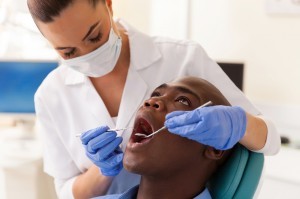
During your regular dental exam, you hygienist might have mentioned that he or she is going to do a quick oral cancer check. So, you lift up your tongue, and the hygienist gently pokes the floor of your mouth and peeks around. But, what’s really going on here?
First, some facts about the disease. Oral cancer can form on the lips, gums, the roof and floor of the mouth, as well as the throat. Although a family history of oral cancers can play a factor in development, it is most commonly caused in people who use tobacco products, drink excessive amounts of alcohol, or who have contracted HPV.
During an oral cancer check, the hygienist will first remove any dentures or retainers you may have. Then, he or she will do a visual inspection of the face, lips, and mouth to check for any unusual bumps or redness. The hygienist will then gently grasp the front of your tongue and check the top, bottom, and sides for any lumps, sores or red and white patches.
Next, the hygienist will examine the soft tissues (the inner cheeks and lips) and will then gently palpitate the floor of your mouth from the top and bottom (under your chin). Again, the hygienist is looking for any lumps, swelling, or red and white patches. The roof or your mouth will also be examined for the same issues.
Finally, the hygienist will feel the lymph nodes in your neck for any swelling, as well as the tonsils to see if they are inflamed or display any redness or bumps.
Although this thorough visual and physical examination is crucial for spotting any potential issues early, it’s also important to realize that oral cancer can be asymptomatic or present itself through issues that seem unrelated. So, it’s important that you point out any oral pain, difficulty chewing or swallowing, speaking, sores or discoloration that don’t resolve within about 2 weeks, or difficulty moving the tongue, as these can also be symptoms of a developing issue.
If the hygienist spots any potential problems, a biopsy may be taken. This is often done through an oral brush biopsy, in which the hygienist uses a small, specially-designed brush to painlessly collect cells from any suspicious areas of the mouth. The cells will then be examined to see if they indicate cancer, pre-cancer, or if they’re benign.
If the test comes back positive for cancer or pre-cancer, then you may have to undergo an incisional or punch biopsy, in which a scalpel or circular blade removes a deeper sample of tissue to check more thoroughly for potentially cancerous cells. Although these are more invasive procedures, the wounds are often small and won’t need stitches to heal.
The oral cancer check is an essential part of your regular dental exam because if spotted early, oral cancers are often highly treatable. To lessen your risk of this disease, be sure to curb heavy alcohol consumption and cease using tobacco products, and make sure you bring up any potential issues with your hyenas and dentist. If something seems off to you, we want to know about it — we’re here to help!







Leave a Reply